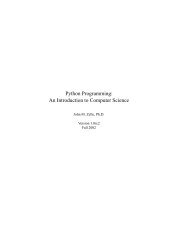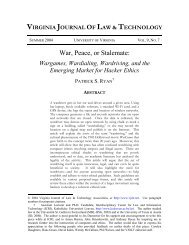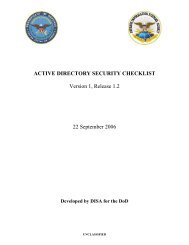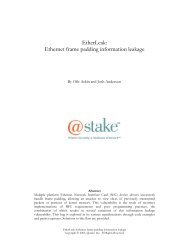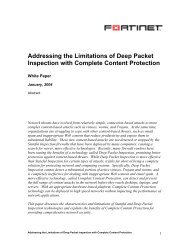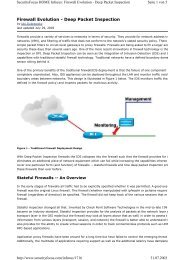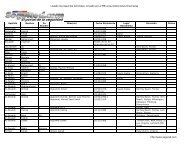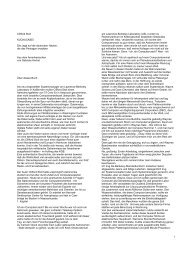New Tool And Technique For Remote Operating ... - Leet Upload
New Tool And Technique For Remote Operating ... - Leet Upload
New Tool And Technique For Remote Operating ... - Leet Upload
You also want an ePaper? Increase the reach of your titles
YUMPU automatically turns print PDFs into web optimized ePapers that Google loves.
<strong>New</strong> <strong>Tool</strong> <strong>And</strong> <strong>Technique</strong> <strong>For</strong> <strong>Remote</strong><br />
<strong>Operating</strong> System Fingerprinting<br />
– Full Paper –<br />
Franck Veysset, Olivier Courtay, Olivier Heen, Intranode Research Team<br />
Abstract – Information gathering is an essential part of<br />
acute vulnerability assessment, especially when the<br />
whole process is automated. In this context, host<br />
<strong>Operating</strong> System detection must be precise, even<br />
when networks are well defended. We present an<br />
original <strong>Operating</strong> System detection method, based on<br />
temporal response analysis. As a proof of concept, we<br />
release the open source tool called RING – for <strong>Remote</strong><br />
Identification Next Generation – and suggest<br />
improvements in the paper. We also stress the<br />
interesting synergy of using RING together with stateof-the-art<br />
tools, such as NMAP [1] or X-Probe [2], for<br />
a better overall accuracy in automated vulnerability<br />
assessment.<br />
Index terms – <strong>Remote</strong> <strong>Operating</strong> System Detection, OS<br />
Fingerprinting, Automated Vulnerability Assessment,<br />
Internet Security.<br />
1 Introduction<br />
In recent years, the need for automated Internet<br />
vulnerability assessment software has been<br />
understood and has resulted in the very fast growth<br />
of widely available solutions.<br />
April 2002, v1.1<br />
As an essential part of the assessment process,<br />
remote <strong>Operating</strong> Systems detection, a.k.a. OS<br />
Fingerprinting, must meet several requirements:<br />
− Accuracy: no falsely detected OS.<br />
− Firewall and IDS neutrality: not be disturbed<br />
by / do not disturb existing firewalls and IDS.<br />
− Politeness: low network traffic and no<br />
dangerous segments.<br />
− Handiness: easily extensible signature database<br />
and automation functions.<br />
− Speed: depending on the usage, a fast<br />
fingerprinting tool might allow large network<br />
scans.<br />
We introduce a new OS Fingerprinting method,<br />
with such good properties and fairly acute results in<br />
practical cases where other tools may fail.<br />
We developed open source software called RING<br />
for both proof of concept and test purpose.<br />
Moreover, we strongly believe that complete access<br />
to source code will encourage and speed-up<br />
collaborative improvements. RING relies on a<br />
signature database that may be enhance, thanks to<br />
the built-in learning mode.<br />
© Intranode Software Technologies – 2002 1
2 State-Of-The-Art<br />
2.1 A brief history of OS Detection<br />
Security Assessors already have a choice of<br />
detection techniques and tools, each of which may<br />
be suitable for some application context.<br />
− Banner grabbing allows OS deduction from<br />
services banner and is appreciated by most<br />
human assessors. This can be completed by<br />
binary file collect and analysis.<br />
− TCP segments (standard or not) response<br />
analysis relies on different <strong>Operating</strong> System<br />
responses to specifically prepared segments,<br />
particularly when response behavior is not<br />
clearly specified in RFCs [3,4]. Furthermore,<br />
vendors have introduced fine tuning and<br />
proprietary extensions into their TCP/IP stack,<br />
which will clearly identify those systems in case<br />
of such solicitations. Popular tools such as<br />
Savage’s QueSO [5] and Fyodor’s NMAP 1 [1]<br />
use many variants of this technique.<br />
− ICMP response analysis is recent. By sending<br />
UDP or ICMP solicitation and analyzing various<br />
ICMP replies, a tool such as Ofir Arkin’s X-<br />
Probe [2] will give precise indication except if<br />
needed protocols are blocked at firewall level.<br />
− Initial Sequence Number (ISN) analysis<br />
exploits differences in TCP stacks random<br />
generators, identified through a sufficient<br />
number of tests [6].<br />
− <strong>Operating</strong> System Specific deny of service are<br />
recalled here for the sake of exhaustively, but<br />
are only used by hackers. Except for very<br />
precise situation, the overall accuracy of this<br />
method is rather bad.<br />
−<br />
1 NMAP has become a de facto standard tool, now<br />
implementing many techniques, including ISN<br />
sampling, ICMP response analysis, UDP probes<br />
replies tests...<br />
<strong>For</strong> a most comprehensive description of various<br />
techniques, see also [7] and Annex 1 – Main<br />
Fingerprinting <strong>Technique</strong>s Comparison.<br />
Figure 1: Synoptic of OS fingerprinting<br />
technologies<br />
2.2 Detailing stack querying techniques<br />
Stack querying techniques allow remote <strong>Operating</strong><br />
System detection by measuring TCP/IP responses to<br />
various solicitations. Most <strong>Operating</strong> System will<br />
answer in a specific manner to specially crafted<br />
TCP/IP requests.<br />
<strong>Tool</strong>s such as NMAP or QueSO are based on such<br />
techniques. They generate a group of TCP and UDP<br />
requests that they send to either opened or closed<br />
ports. Then the remote system responses – that can<br />
be usual or unusual – are analyzed, providing useful<br />
information for eventually deducing the identity of a<br />
precise <strong>Operating</strong> System.<br />
Those techniques generally allow security assessors<br />
to get information such as type and version about<br />
the target system in a fairly short delay.<br />
Several factors explain the accuracy of the stack<br />
querying method:<br />
− Each <strong>Operating</strong> System or even patch version<br />
usually may use its own implementation of the<br />
IP stack.<br />
© Intranode Software Technologies – 2002 2
− TCP/IP specifications are not entirely respected<br />
and each different implementation has its own<br />
characteristics that can potentially reveal the<br />
<strong>Operating</strong> System.<br />
− Specifications can be interpreted and some<br />
features are optional, some constructors<br />
implement those features some don’t.<br />
− Some proprietary IP improvements are<br />
sometimes implemented and are characteristic<br />
of an <strong>Operating</strong> System.<br />
2.3 Common limitations of classical tools<br />
NMAP can identify over 500 different <strong>Operating</strong><br />
Systems, but to do so tests have to be performed in<br />
good conditions i.e. on an opened TCP port, a<br />
closed one and an closed UDP port. If those<br />
requirements are not met the accuracy of the<br />
detection will decrease.<br />
With new security policy being used on Internet<br />
connected systems, many machines just have one<br />
opened TCP port viewable from Internet, every<br />
other port being filtered by adequate firewalls or<br />
packet filters.<br />
In such a basically secured environment, NMAP,<br />
and Xprobe tools, based on ICMP, closed UDP<br />
ports, and TCP close ports won’t work properly.<br />
3 Needed TCP/IP Material<br />
To make a self-contained paper, we recall some of<br />
the most important TCP/IP characteristics.<br />
TCP is a networking protocol whose definition can<br />
be found in RFC 793 [3]. ISO norm defines TCP as<br />
a data transmission protocol situated over IP.<br />
TCP/IP is the main protocol used within the Internet<br />
world [9].<br />
Its reliability is the key of its success: Error<br />
detection and management, flow and congestion<br />
control, duplication control, packet reordering.<br />
To meet this requirements, TCP is connectionoriented.<br />
The general scheme is as follows:<br />
1. Connection establishment.<br />
2. Data transfer.<br />
3. Connection Termination.<br />
TCP relies on IP for packet routing over Internet.<br />
As network congestion or routing problems can<br />
occur, IP can’t be trusted for end-to-end packet<br />
transmission. Furthermore, IP is a fully<br />
connectionless protocol. Thus, connection control<br />
has to be performed at the TCP level.<br />
TCP headers contain several fields to manage those<br />
features, as show in the table hereafter.<br />
Source Port Destination Port<br />
Hlen 0 U<br />
R<br />
G<br />
Sequence Number<br />
Acknowledgement Number<br />
© Intranode Software Technologies – 2002 3<br />
A<br />
C<br />
K<br />
P<br />
S<br />
H<br />
R<br />
S<br />
T<br />
S<br />
Y<br />
N<br />
F<br />
I<br />
N<br />
Window<br />
Size<br />
Checksum Urgent Pointer<br />
TCP Options<br />
Figure 2: Simplified TCP header<br />
The “Sequence Number” and “Acknowledgement<br />
Number” fields are used to manage reordering and<br />
control particular errors. The URG, ACK, PSH,<br />
RST, SYN and FIN fields are used to manage the<br />
connection state. RFC 793 defines a state transition<br />
diagram for a TCP connection (see Figure 3:<br />
Simplified TCP State diagram).<br />
Figure 3: Simplified TCP State diagram
<strong>For</strong> a better understanding of further explained<br />
RING algorithm, it is important to recall the TCP/IP<br />
three-way handshake, i.e. the connection<br />
establishment method between a client (A) and a<br />
server (B).<br />
Figure 4: Three-Way Handshake diagram<br />
As some packets might get lost during an IP<br />
transmission, "every" packet has to be<br />
acknowledged by the receiver. Note that TCP<br />
maintains a list of acknowledged packets.<br />
If a packet has not been acknowledged quickly<br />
enough to the server, it considers this packet as<br />
being lost and resends it.<br />
Moreover, TCP reorders the incoming packets if<br />
necessary, so that data is passed in correct sequence<br />
to the upper layer.<br />
Network congestion could cause packets to get lost.<br />
Any network has a maximum packet per second<br />
capacity due to either physical or router<br />
performance.<br />
If network congestion occurs, there might be some<br />
packet losses. As TCP retransmits lost packets, the<br />
congestion problem gets worse and worse.<br />
Consequently, if congestion occurs, packet<br />
retransmission should be delayed. In other words,<br />
the transmission delay in between 2 packets has to<br />
increase [9].<br />
This mechanism is specified by TCP, but RFC 793<br />
does not impose any algorithm to compute the<br />
acknowledgement delays, it just suggests one.<br />
About the retransmission algorithm (RFC 2988)<br />
TCP is very sensitive to the RTO timer duration:<br />
− Too short: useless retransmission<br />
− Too long: the retransmission comes too late<br />
The protocol has to be efficient for any transmission<br />
condition:<br />
− LAN or WAN, heavy or light load<br />
− The timer duration has to be computed<br />
according to the Round Trip Time.<br />
RTT evaluation:<br />
− RTT=(α *old_RTT)+((1-α )*measured_RTT),<br />
α ∈[0-1]<br />
− The length of a round trip in between a segment<br />
transmission and its acknowledgement.<br />
Segment retransmission and merging make this<br />
assessment difficult.<br />
Karn algorithm<br />
While a packet is being retransmitted<br />
RTO = d*old_RTO, d=2<br />
The first implementations proposed<br />
RTO = d*RTT, d=2<br />
The most recent implementations use a variancebased<br />
computation<br />
E=((1-j)*old_E) + j*|old_RTT - measuredRTT|)<br />
RTO =RTT + h * E, h=4, j=1/4<br />
© Intranode Software Technologies – 2002 4
4 Temporal analysis<br />
4.1 Principle description<br />
Packet retransmission offers a pattern that can be<br />
analyzed from a remote host.<br />
Such patterns are defined in the norm (RFC 793)<br />
but it leaves plenty of scope. Moreover, some of the<br />
implementations don’t scrupulously respect the<br />
norm.<br />
To have a chance of observing these patterns, one<br />
must force the target IP stack in a non-standard<br />
situation, where timeouts values will be reached.<br />
This can be done by simulating network congestion,<br />
simply avoiding to acknowledge the SYN-ACK<br />
packets the target emits.<br />
By measuring the delay between packet<br />
retransmission, or by looking at some other kind of<br />
information such as TCP flags, sequence number or<br />
acknowledge number, it is possible to get revealing<br />
information about the target behavior.<br />
If every <strong>Operating</strong> System has its own behavior, it<br />
is possible to establish a typical system signature.<br />
Whatever the tested machine or the testing<br />
conditions, the <strong>Operating</strong> System is the only<br />
element leading the tested machine behavior.<br />
Therefore a given test realized on different<br />
machines, using the same <strong>Operating</strong> System, will<br />
produce the same result (provide that networks<br />
conditions doesn’t vary too much).<br />
Comparing the target <strong>Operating</strong> System fingerprint<br />
and the <strong>Operating</strong> System typical fingerprint, it<br />
becomes possible to find out which <strong>Operating</strong><br />
System is running on the target machine.<br />
<strong>New</strong> <strong>Operating</strong> System signature can be easily<br />
recorded, then associated to the <strong>Operating</strong> System<br />
name.<br />
Whenever this pattern is observed again it will be<br />
easy to recall the learned signature and associated<br />
name, which identifies the <strong>Operating</strong> System.<br />
4.2 Doing it yourself<br />
The <strong>Operating</strong> System fingerprinting method uses<br />
two components of the detector: a packet filter<br />
function – such as provided by personal firewalls –<br />
together with a packet listening function.<br />
Detector configuration: a simple method to<br />
simulate network congestion is to set up a personal<br />
firewall on the scanner machine and to create some<br />
filtering rules forbidding any incoming traffic from<br />
the target machine.<br />
Then a listening mechanism has to be set up for all<br />
the packets emitted from the target machine. So the<br />
scanner machine TCP/IP stack does not send any<br />
SYN/ACK or RST packet that would inform the<br />
target machine its packet is received, and thus<br />
disable the expected behavior.<br />
Therefore the same machine has to be used as an IP<br />
sender, a packet filter and a packet listener.<br />
Test progress: This test progress is composed of<br />
three different steps.<br />
− Firewall set up.<br />
− Standard connection attempt on the audited<br />
machine.<br />
− Target machine emitted packets monitoring.<br />
Here are the rules to apply to notice retransmission<br />
effects: for every following steps the commands are<br />
given for Linux 2.4. Note that a packet sniffing tool,<br />
such as TCPDump [10], and a command line<br />
segment-forging tool, such as SendIP [11] are<br />
required.<br />
− Choose a host with a known open port. Let’s<br />
assume than machine 192.168.1.10 has TCP<br />
port 80 open (for example, this system is a web<br />
server)<br />
− Configure your firewall to block every<br />
incoming packets from the target machine.<br />
#> iptables –A INPUT –source<br />
192.168.1.10 –p TCP –sport 80 –<br />
dport 62302 –j DROP.<br />
− Listen to every packets coming from the target<br />
and from the open port on the machine.<br />
Command line is:<br />
© Intranode Software Technologies – 2002 5
#> tcpdump –n host 192.168.1.10<br />
and port 80 and port 62302.<br />
− Send a TCP SYN packet to attempt a<br />
connection establishment. Command line (on a<br />
different shell) is:<br />
#> sendip 192.168.1.10 –p TCP –is<br />
your_ip_address –ts 62302 –td 80.<br />
− Analyse the delay between every try from the<br />
target machine. See Figure 5 for a general<br />
scheme of segments transmission. Extensive<br />
tcpdump results are indicated below.<br />
14:13:12.480412 192.168.1.2.62302 ><br />
192.168.1.10.80: S 221002:221002(0) win 1024<br />
[tos 0x10]<br />
14:13:12.480871 192.168.1.10.80 ><br />
192.168.1.2.62302: S<br />
3566819867:3566819867(0) ack 221003 win 5840<br />
(DF)<br />
14:13:16.876294 192.168.1.10.80 ><br />
192.168.1.2.62302: S<br />
3566819867:3566819867(0) ack 221003 win 5840<br />
(DF)<br />
14:13:22.876230 192.168.1.10.80 ><br />
192.168.1.2.62302: S<br />
3566819867:3566819867(0) ack 221003 win 5840<br />
(DF)<br />
14:13:34.876110 192.168.1.10.80 ><br />
192.168.1.2.62302: S<br />
3566819867:3566819867(0) ack 221003 win 5840<br />
(DF)<br />
14:13:59.075843 192.168.1.10.80 ><br />
192.168.1.2.62302: S<br />
3566819867:3566819867(0) ack 221003 win 5840<br />
(DF)1<br />
In fact the measure is not based on the time interval<br />
in between each retransmission but on the interval<br />
in between each packet reception. As the trip time is<br />
almost constant, we can assume that those two<br />
durations are equal.<br />
Figure 5: Sending SYN, then ignoring SYN-ACK<br />
replies<br />
4.3 Modeling and statistical analysis<br />
Automating this method requires several<br />
components:<br />
1. A test and result model.<br />
2. A raw results analysis module.<br />
As the packets may cross an unstable network, such<br />
as the Internet, it is likely that the delay between<br />
successive packets (λi) doesn’t exactly equal the<br />
delay between these same packets (ti) at the moment<br />
they were sent. See Figure 5.<br />
When two packets are received with a 3.01 second<br />
time interval it is very probable that the emission<br />
time interval was 3.0 seconds. But some algorithm<br />
implementations use 3.2 seconds as a time interval<br />
in between packet emissions. The gap between 3.2<br />
and 3.0 is too small for distinguishing one form to<br />
the others.<br />
To avoid this problem it is possible to use the TCP<br />
Timestamp option, and then gain a better<br />
knowledge of when the packet was emitted, at least<br />
relatively to the target time reference. Asking for the<br />
emission time for every packet on the target<br />
machine increases the accuracy of time interval<br />
measures. Nevertheless, using timestamps may be<br />
intricate as the number given by the TCP timestamp<br />
option isn't exactly the date. Rather it is <strong>Operating</strong><br />
© Intranode Software Technologies – 2002 6
System dependant increment (generally ranking<br />
from 1 ms to 1 second).<br />
This method is based on the reference fingerprints<br />
creation and then on a comparison with the<br />
experience results. The norm used to measure those<br />
distances is the distance in between number series.<br />
Distance = Σ | λi - δ i | , λ i is the time interval<br />
associated to the reception time for packet i, δ i is<br />
element i from the fingerprint.<br />
Therefore the qualified OS is the one whose<br />
distance is the shortest. This distance does not<br />
consider some important packet characteristics such<br />
as flags (SYN, ACK, RST, FIN...) used to know the<br />
tested machine state or sequence and<br />
acknowledgement numbers used to point out some<br />
differences between different implementations.<br />
Those features improve the results given by the time<br />
measure method by rejecting some fingerprints.<br />
5 RING: implementation <strong>And</strong><br />
Practical Results<br />
As a proof of concept, we developed the RING tool.<br />
5.1 Libraries<br />
In order to be portable RING has been developed<br />
using standard C programming language and some<br />
specific UNIX libraries such as Dug Song’s Libdnet<br />
library [12], Mike D. Schiffman Libnet library [13]<br />
and Lawrence Berkeley national laboratory Libpcap<br />
library [14].<br />
The Libdnet library is mainly used for firewall<br />
control. It provides a development API allowing to<br />
control several UNIX firewalls (ipchains, ipfilters,<br />
ipf...)<br />
Libpcap is a very common library used to listen and<br />
analyze packets on a network without having to use<br />
the conventional IP stack.<br />
Libpcap used by RING is taken from NMAP<br />
(including Fyodor's modifications).<br />
5.2 Algorithm<br />
The initial arguments needed to perform OS<br />
detection with RING are the target host IP address,<br />
an opened port on this host, the scanner IP address,<br />
and the network interface used to listen to the target<br />
responses.<br />
Then RING performs the following internal and<br />
network actions:<br />
− Source port choice.<br />
− Using libdnet, set up a local filtering function<br />
for blocking every incoming packet from the<br />
target machine.<br />
− Using libpcap (pcap descriptor opening), start<br />
the packet listening using the filter defined<br />
above.<br />
− Using libnet, send a TCP SYN packet to the<br />
target machine.<br />
− Listen to the responses for a default or user<br />
adjusted delay.<br />
− Compare the obtained responses to the known<br />
signatures.<br />
This comparison is based on various parameters:<br />
measured values, global duration of measurement,<br />
the signature itself and global duration of signature<br />
measurement.<br />
Global durations are important. <strong>For</strong> instance, after<br />
10 seconds it is not possible to distinguish FreeBSD<br />
from Windows 2000, the behavior of those two<br />
systems are identical. 12 second after the beginning<br />
a 3 rd SYN-ACK may be received and permit<br />
separation between these <strong>Operating</strong> Systems.<br />
This is the reception or the not-reception of a<br />
segment 12 second after the 3rd SYN-ACK that<br />
makes it possible to highlight the difference.<br />
Let δi (0
− n>m and T_S
RST packet to warn the scanner machine the<br />
transmission has been broken.<br />
6 Discussion and extensions<br />
6.1 Advantages<br />
The main advantage of RING’s method is the use of<br />
only one opened port. If the target system is well<br />
protected, behind a firewall, chance are that only<br />
one port will be open, all other being filtered.<br />
With this kind of configurations, tools such as<br />
NMAP are not as efficient because lots of NMAP<br />
tests are based on closed ports.<br />
Moreover, the proposed technique uses a standard<br />
TCP packet. RING testing won’t disturb the<br />
machine.<br />
Only few implementations change their TCP state<br />
diagram between two versions.<br />
There are only a few differences between Win98<br />
Millennium edition, Windows 2000 and Windows<br />
XP. Nevertheless, in order to improve their<br />
efficiency the values used by the algorithm are<br />
changed more often.<br />
As a matter of fact, the proposed method has a<br />
better accuracy than the classical techniques for<br />
some implementation.<br />
On the other hand, note that this method takes more<br />
time than techniques used by NMAP or Xprobe.<br />
This is an inherent drawback as successive times are<br />
measured.<br />
6.2 Protection<br />
What are the available protections to escape RING<br />
<strong>Operating</strong> System detection? As the packet sent is<br />
standard and unique, it is impossible to distinguish<br />
it from any normal traffic on the target machine.<br />
Packet retransmissions are visible but packet loss<br />
and retransmission are normal for any network.<br />
If an IDS aborts a connection in order to prevent<br />
too much information from leaving the network it is<br />
going to decrease the TCP error recovery capacities.<br />
With some <strong>Operating</strong> Systems, it is possible to<br />
modify some elements in the TCP/IP stack, allowing<br />
the system to hide its identity to RING. This method<br />
is not advised because it is dangerous for TCP/IP<br />
stack stability.<br />
A possible method is to hide the machines behind a<br />
proxy or use Firewall that implement SYN Relay or<br />
SYN Gateway techniques. SYN Relay or SYN<br />
Defender is use to protect host against TCP<br />
Flooding.<br />
Thus, the audited stack TCP/IP is the stack of the<br />
Firewall instead of the tested host.<br />
SYN Relay principle<br />
If after a certain time no ACK receive by FW, the<br />
connection is aborted. Otherwise, the transmissions<br />
continues:<br />
© Intranode Software Technologies – 2002 9
SYN Gateway principle<br />
If after a certain time no ACK receive by FW, the<br />
connection is aborted:<br />
Otherwise, the transmissions continues:<br />
6.3 Further improvements<br />
There exist other states in TCP transition diagram<br />
that will show similar behavior, trying to reinject<br />
supposedly lost segments. This is the case for<br />
FIN_WAIT_1 state that can be used to corroborate<br />
previous OS deductions and / or bypass some SYN<br />
defenders.<br />
FIN_WAIT_1 is a really interesting state as it allows<br />
a TCP flag differences analysis. Those differences<br />
are similar to the ones used by Nmap, but Nmap<br />
can’t see them because it is necessary to put the<br />
machine in a FIN_WAIT_1 to observe them.<br />
The interesting fact about this method is that it will<br />
bypass SYN gateway mechanism, and perform OS<br />
fingerprinting tests on the real target.<br />
Retries Linux 2/4 Win 2K<br />
1 st 0,8 3<br />
2 nd 1,3 6<br />
3 rd 2,6 12<br />
4 th 5,2 24<br />
5 th 10,5 48<br />
6 th 20,8 No more retries<br />
7 th 41,6<br />
8 th No more retries<br />
Reset No Reset No Reset<br />
Further researches on this topic could concern<br />
independence in regard to network performance<br />
variation and global robustness of RING detection.<br />
Indeed, we experiment some instabilities during<br />
some measurement sessions. Repetitive measures<br />
with some aberrant value detection may help in<br />
cases where the network is very unsteady. As<br />
indicated in § 4.3, we may use the timestamp TCP<br />
field in some cases and then calculate more precise<br />
duration between successive segments sending.<br />
Lastly, we feel that known signature file must grow,<br />
and guess that open source developer’s community<br />
will help. We encourage sending comments and<br />
newly found signatures to ring@intranode.com<br />
7 Conclusions<br />
Figure 6: Synoptic of <strong>Operating</strong> System<br />
fingerprinting technologies, now including<br />
temporal analysis<br />
RING uses a brand new <strong>Operating</strong> Systems<br />
detection technique, that relies on very common and<br />
noiseless TCP traffic. Automated vulnerability<br />
assessment engines may greatly benefit form RING,<br />
especially when used in conjunction with other<br />
techniques (see figure 4).<br />
<strong>For</strong> further reading and information concerning<br />
RING, a full paper can be found at this URL:<br />
© Intranode Software Technologies – 2002 10
www.intranode.com/site/techno/ring-full-paper.pdf<br />
The open source version of RING, with associated<br />
libraries, man page and an evolutive signature<br />
database can be found at this URL:<br />
www.intranode.com/site/techno/techno_articles.htm<br />
Any comment or suggestion may be sent to the alias<br />
ring@intranode.com<br />
8 Acknowledgements<br />
The authors would like to thank Fyodor, D. <strong>For</strong>t,<br />
P. Auffret, F. Frade, A. Floch and C. Patel for<br />
valuable comments.<br />
9 References<br />
[1] Fyodor, NMAP, www.insecure.org/nmap<br />
[2] Arkin, O., X-Probe,<br />
www.sys-security.com/html/projects/X.html<br />
[3] Postel, J. (Sep, 1981), RFC 793 –<br />
Transmission Control Protocol<br />
[4] Paxson, V. and Allman, M. (Nov, 2000), RFC<br />
2988 – TCP Retransmission Timer<br />
[5] Savage, QueSO,<br />
savage.apostols.org/projects.html<br />
[6] Zalewski, M. (Apr, 2001), Strange Attractors<br />
and TCP/IP Sequence Number Analysis<br />
[7] Veysset, F. (Jun, 2001), 13th Annual FIRST<br />
Conference – OS Fingerprinting Revisited<br />
[8] Comer, D and Lin, J. (1994), Probing TCP<br />
implementations<br />
www.cs.purdue.edu/homes/lin/probe.tcp.html<br />
[9] Stevens, W. R. (1994), TCP/IP Illustrated,<br />
Vol. 1<br />
[10] TCPDump, www.tcpdump.org<br />
[11] SendIP, freshmeat.net/projects/sendip<br />
[12] Libdnet, libdnet.sourceforge.org<br />
[13] Libnet,www.packetfactory.net/Projects/Libnet<br />
[14] Libpcap, www.tcpdump.org<br />
© Intranode Software Technologies – 2002 11
10 Annex 1 – Main Fingerprinting <strong>Technique</strong>s Comparison<br />
OS Fingerprinting Banner ICMP replies Non standard Sequence Time based<br />
<strong>Technique</strong>s Comparison<br />
History<br />
Grabbing<br />
segments analysis<br />
Classical implementation Plenty X-PROBE NMAP ? RING<br />
Created by Hackers Ofir Arkin Fyodor M. Zalewsky Intranode<br />
F. Yarochkin<br />
Guardent<br />
First released<br />
IP Protocol & Service<br />
? Aug, 2001 Jun, 1998 Apr, 2001 Mar, 2002<br />
Used protocols Service related UDP & ICMP IP, TCP, UDP &<br />
ICMP<br />
TCP TCP<br />
Open TCP port requiered<br />
Closed TCP port requiered<br />
Closed UDP port requiered<br />
Firewall concerns<br />
Service related<br />
No<br />
No<br />
No<br />
No<br />
Yes<br />
The more the<br />
better<br />
Yes<br />
No<br />
No<br />
Yes<br />
No<br />
No<br />
Bypass filtering routers Always Rarely Generally Generally Generally<br />
Bypass SYN relays Always Always Rarely Never Never<br />
Bypass application proxies Rarely Never Never Never Never<br />
Outgoing firewall neutral<br />
IDS concerns<br />
Always Generally Generally Always Always<br />
Detection Hard Possible Easy Easy (?) Hard<br />
Blocking<br />
Misc.<br />
Hard Possible Possible Possible Hard<br />
Learning functions No No Yes ? Yes<br />
KB size (March 2002) ? ~ 20 (?) > 600 ~ 10 (?) ~ 30<br />
Target hosts disturbance None None Rare Possible None<br />
Best match feature No ? Yes ? Yes<br />
Defensive measures Banner ICMP blocking Firewall or host SYN Relaying SYN Relaying<br />
rewriting at firewall stack tuning<br />
© Intranode Software Technologies – 2002 12
11 Annex 2 – Ring Man Page<br />
NAME<br />
ring 0.0.1 - <strong>Remote</strong> Identification Next<br />
Generation.<br />
<strong>Remote</strong>ly detects OS types and versions.<br />
SYNOPSIS<br />
ring [-v][-f fingerprint][–t timeout] –d target_ip<br />
–s source_ip –p open_port –i device<br />
DESCRIPTION<br />
Ring performs remote <strong>Operating</strong> System detection based<br />
on<br />
temporal analysis of target reemitted SYN-ACK segments.<br />
measured values are compared to reference values<br />
stored<br />
in the fingerprint file using a best match algorithm.<br />
OPTIONS<br />
TIPS<br />
a<br />
-d target<br />
IP address of the tested host<br />
-s src<br />
IP address of your host<br />
-p open_port<br />
An open TCP port on the target<br />
-i device<br />
the name of your network interface for reach<br />
tested host<br />
-t timeout<br />
duration for waiting packet<br />
-v(erbose)<br />
<strong>For</strong> analysis and debugging purpose.<br />
-f(ingerprint) fingerprintfile<br />
Use alternate signature file.<br />
default is ./fingerprint<br />
The same signature may appear more than once in<br />
signature file, with slightly different values.<br />
It might be usefull to create specialized<br />
signature<br />
files: one for intranet, one for internet with<br />
possible<br />
distortion...<br />
© Intranode Software Technologies – 2002 13




